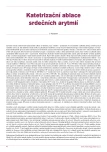Catheter ablation of accessory links: solved question?
Authors:
L. Haman P. Pařízek 1,2 2
Authors‘ workplace:
Katedra válečného vnitřního lékařství Fakulty vojenského zdravotnictví Univerzity obrany, Hradec Králové
1; I. interní klinika LF UK a FN Hradec Králové
2
Published in:
Kardiol Rev Int Med 2006, 8(Supplementum): 20-23
Overview
Definition:
Accessory pathways are inherited anomalous atrioventricular connections that predispose to supraventricular tachyarrhythmias.
Key features:
There are 2 main forms of accessory pathways –atrioventricular (98 %) and atriofascicular (2 %). Clinical manifestation occurs usually in infancy or in pubescent period in the form of supraventricular tachycardia and/or atrial fibrillation (30 %). Approximately 50 % of patients may be asymptomatic. Rarely there is association with sudden death due to ventricular fibrillation triggered by atrial fibrillation with rapid conduction to the ventricles via the accessory pathway.
Therapy:
Catheter ablation is highly effective method with a low risk and is the preferred therapy for symptomatic patients.
Key words:
preexcitation - accessory pathway - catheter ablation
Sources
1. Munger TM, Packer DL, Hammill SC et al. A population study of the natural history of Wolff-Parkinson-White syndrome in Olmsted County, Minnesota, 1953-1989. Circulation 1993; 87: 866-873.
2. Priori SG, Aliot E, Blomstrom-Lundquist C et al. Task force on sudden cardiac death of the European Society of Cardiology. Eur Heart J 2001; 22: 1374-1450.
3. Gollob MH, Green MS, Tang AS et al. Identification of a gene responsible for familial Wolff-Parkinson-White syndrome. N Engl J Med 2001; 344: 1823-1831.
4. Borggrefe M, Budde T, Podczek A et al. High frequency alternating current ablation of an accessory pathway in humans. J Am Coll Cardiol 1987; 10: 576-582.
5. Calkins H, Yong P, Miller JM, et al. Catheter Ablation of Accessory Pathways, Atrioventricular Nodal Reentrant Tachycardia, and the Atrioventricular Junction: Final Results of a Prospective, Multicenter Clinical Trial. Circulation 1999; 99: 262-270.
6. Scheinman MM, Huang S. The 1998 NASPE prospective catheter ablation registry. Pacing Clin Electrophysiol 2000; 23: 1020-1028.
7. Hindricks G. Multicentre European Radiofrequency Survey (MERFS): Complications of radiofrequency catheter ablation of arrhythmias. Eur Heart J 1993; 14: 1644-1653.
8. Langberg JJ, Ching Man K, Vorperian VR et al. Recognition and catheter ablation of subepicardial accessory pathways. J Am Coll Cardiol 1993; 22: 1100-1104.
9. Bubien RS, Knotts-Dolson SM, Plumb VJ et al. Effect of Radiofrequency Catheter Ablation on Health-Related Quality of Life and Activities of Daily Living in Patients With Recurrent Arrhythmias. Circulation 1996; 94: 1585-1591.
10. Lau CP, Tai YT, Lee PWH. The effects of radiofrequency ablation versus medical therapy on the quality-of-life and excercise capacity in patients with accessory pathway-mediated supraventricular tachycardia: a treatment comparison study. PACE 1995; 18: 424-432.
11. Saul PS, Epstein MR, Triedman JK et al. Embolic complications associated with RF ablation procedures: Does the risk extend beyond the procedure? (abstract) Pacing Clin Electrophysiol 1995; 18: 818 II.
12. Yeh SJ, Wang CC, Wen MS et al. Characteristics and radiofrequency ablation therapy of intermediate septal accessory pathway. Am J Cardiol 1994; 73: 50-56.
13. Solomon AJ, Tracy CM, Swartz JF et al. Effect on coronary artery anatomy of radiofrequency catheter ablation of atrial sites of accessory pathways. J Am Coll Cardiol 1993; 21: 1440-1444.
14. Fiala M. Doporučené postupy pro diagnostiku a léčbu supraventrikulárních tachyarytmií. Cor Vasa 2005; 47(9, Suppl K):18-39.
15. Pappone C, Santinelli V, Rosanio S et al. Usefulness of invasive electrophysiologic testing to stratify the risk of arrhythmic events in asymptomatic patients with Wolff-Parkinson-White pattern. J Am Coll Cardiol 2003; 41: 239-244.
16. Pappone C, Manguso F, Santinelli R et al. Radiofrequency ablation in children with asymptomatic Wolff-Parkinson-White syndrome. N Engl J Med 2004; 351: 1197-1205.
Labels
Paediatric cardiology Internal medicine Cardiac surgery CardiologyArticle was published in
Cardiology Review

2006 Issue Supplementum
Most read in this issue
- Catheter ablation of atrioventricular nodal reentrant tachycardia: therapy of the first choise?
- Catheter-based treatment of common atrial flutter yesterday and today
- Catheter ablation of accessory links: solved question?
- AV node ablation: new aspects in the time of curative therapy of atrial fibrillation and cardiac resynchronization therapy
